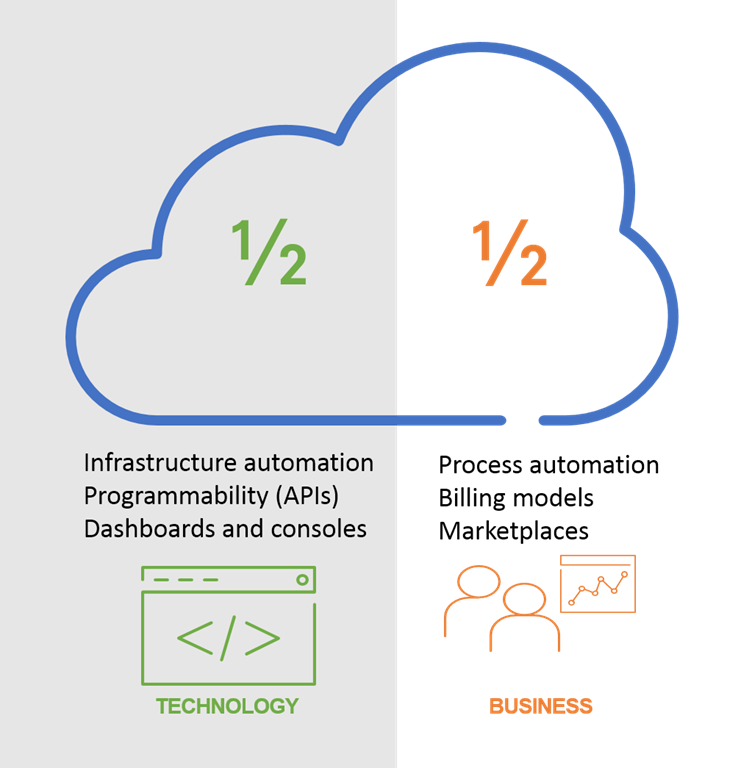Meia nuvem é melhor do que nenhuma nuvem
Toda vez que uma nova tecnologia ou abordagem à computação entra em nosso campo de visão, ela é imediatamente aproveitada e definida como sendo “x”. Talvez seja baseado em características, como elasticidade e um modelo de negócios baseado em utilidade. Talvez seja acompanhado por um mnemônico como CAMS para identificar claramente quais componentes são necessários para ser considerado um “X real”.
E se você não cumprir os requisitos definidos por, bem, outra pessoa, os especialistas descartarão seus esforços como sendo “não X”. Porque nenhum X verdadeiro deixaria de incluir Y*.
Lembrei-me dessa verdade existencial durante uma conversa no Twitter, na qual alguém observou que “infraestrutura automatizada não é nuvem”.
Agora, com base em algumas definições de “nuvem”, isso é verdade. De fato, algumas definições de nuvem tornam impossível para uma empresa implementar um modelo de computação em nuvem no local. Outros tornam isso possível, mas improvável. E outros ainda são tão vagos que incluem SaaS como um exemplo válido de “nuvem”.

Sim, eu fui lá. Anos atrás.
A questão é a seguinte: as empresas não se importam se receberão um adesivo “100% Nuvem” de alguém na Internet para validar sua implementação. Os argumentos contra a nuvem privada (local) giram há anos em torno do fato de a nuvem pública ser mais rápida, mais eficiente e mais ágil do que suas primas vinculadas a data centers. A realidade é que toda forma de nuvem inclui como parte de sua implementação a infraestrutura de automação. Sem ele, você não obtém a rapidez do provisionamento, nem a flexibilidade do dimensionamento automático, nem os recursos de "ligar e desligar" inerentes ao modelo de nuvem.
Metade da nuvem é apenas tecnologia. A outra metade é faturamento, serviços e automação de processos.
Ouvi clientes rejeitarem em alto e bom som (e com certo desprezo) a “nuvem”, e parte desse desdém surge de uma abordagem muitas vezes procustiana à tecnologia e sua adaptação pela empresa. Procrustes, como você deve se lembrar, é um dos vários vilões derrotados pelo herói grego Teseu. Nos contos, Procrustes convida os transeuntes para passar a noite ali e depois passa a noite fazendo-os se ajustarem à cama usando qualquer técnica que seja apropriada ao seu corpo. (Vou deixar você imaginar como ele faria isso, mas no final, ninguém sobreviveu). “Procusto é usado para descrever situações em que diferentes comprimentos, tamanhos ou propriedades são ajustados a um padrão arbitrário.” ( Wikipedia )
Se tudo o que as empresas fazem é automatizar a infraestrutura e chamá-la de nuvem, e daí? Se não se encaixa na definição de Procusto, mas realiza os resultados que eles buscam, isso importa? Eles querem que os aplicativos sejam entregues de forma mais rápida, inteligente e segura. Eles não estão interessados em saber se estão implementando uma nuvem inteira ou apenas metade. Contanto que eles façam o trabalho mais rápido, com mais eficiência e com mais agilidade do que faziam no passado, será uma vitória para a TI e para o negócio. Esse é o objetivo de adotar qualquer tecnologia ou metodologia.
Porque todas essas coisas são relativas. Mais rápido . Mais eficiente. Maior agilidade. Não se trata de atingir equivalência com provedores de nuvem pública, o que eles não podem fazer porque não têm volume (e motivação empresarial), mas sim de fornecer serviços de TI na velocidade dos negócios. As empresas não estão interessadas em um selo de mérito declarando sua “pureza de nuvem” para que seu CIO possa orgulhosamente declarar “conquista desbloqueada”. Eles estão interessados em melhorar a maneira como a TI fornece seus serviços para o resto da empresa.
Então sim, pode ser verdade que quando as empresas afirmam estar fazendo “nuvem” na verdade não estão, segundo aqueles com uma perspectiva procrustina. Talvez tudo o que eles estejam fazendo seja automatizar a infraestrutura e alguns processos manuais para melhorar a velocidade, a agilidade e a entrega de seus serviços e, consequentemente, os aplicativos de que a empresa precisa. Mas no final do dia, isso é metade da nuvem.
E meia nuvem é melhor do que nenhuma.
* Este é o equivalente técnico da falácia lógica do No True Scotsman. Leitores antigos notarão que falácias lógicas fazem a bebê Lori chorar.
